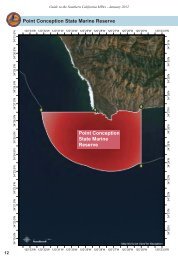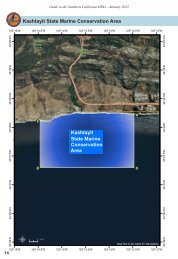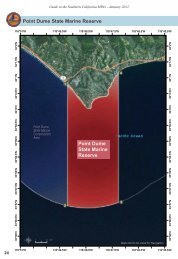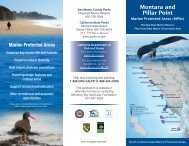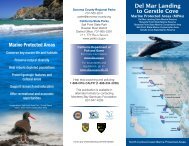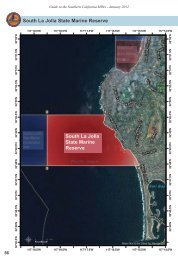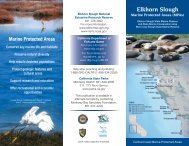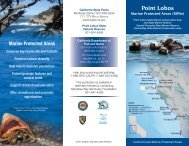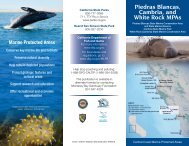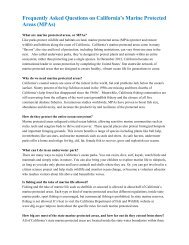Point Arena to Saunders Reef
Point Arena Brochure - California MPA Educational Resources
Point Arena Brochure - California MPA Educational Resources
You also want an ePaper? Increase the reach of your titles
YUMPU automatically turns print PDFs into web optimized ePapers that Google loves.
Marine Protected Areas<br />
Conserve key marine life and habitats<br />
Preserve natural diversity<br />
Help rebuild depleted populations<br />
Protect geologic features and<br />
cultural areas<br />
Support research and education<br />
Offer recreational and economic<br />
opportunities<br />
Image above: Schooner Gulch State Beach (Oscar Vasquez)<br />
below: sea star (Oscar Vasquez)<br />
Bureau of Land Management<br />
Ukiah Field Office<br />
2550 North State Street<br />
Ukiah, CA 95482<br />
707-468-4000<br />
California State Parks<br />
Russian River District<br />
District Office: 707-865-2391<br />
711, TTY Relay Service<br />
www.parks.ca.gov<br />
California Department of<br />
Fish and Game<br />
For more information:<br />
www.dfg.ca.gov<br />
For boundaries and<br />
regulations, go <strong>to</strong>:<br />
www.dfg.ca.gov/MLPA<br />
Help s<strong>to</strong>p poaching and polluting:<br />
1-888-DFG-CALTIP (1-888-334-2258)<br />
This publication is available in<br />
alternate formats by contacting<br />
Monterey Bay Sanctuary Foundation:<br />
831-647-4209<br />
<strong>Point</strong> <strong>Arena</strong> <strong>to</strong><br />
<strong>Saunders</strong> <strong>Reef</strong><br />
Marine Protected Areas (MPAs)<br />
<strong>Point</strong> <strong>Arena</strong> State Marine Reserve<br />
<strong>Point</strong> <strong>Arena</strong> State Marine Conservation Area<br />
Sea Lion Cove State Marine Conservation Area<br />
<strong>Saunders</strong> <strong>Reef</strong> State Marine Conservation Area<br />
Cover: California sea lions (Nehring)<br />
North Central Coast Marine Protected Areas
From rocky shores <strong>to</strong> the depths of the Pacific Ocean<br />
California Is Making a Difference<br />
by creating a statewide network of marine<br />
protected areas (MPAs). Marine protected<br />
areas are underwater places designed<br />
<strong>to</strong> protect key habitats and species by<br />
prohibiting or restricting the take of marine<br />
life. Just as the nation’s parks, forests and<br />
wilderness areas protect special places<br />
on land, California’s MPAs protect unique<br />
areas in the ocean and estuaries. The<br />
California MPA network includes the many<br />
different types of habitats found along our<br />
coast, from sheltered estuaries <strong>to</strong> rocky<br />
intertidal areas and lush kelp forests <strong>to</strong><br />
steep underwater canyons.<br />
Image above left: nudibranch (Ken Bondy)<br />
above right: kelp (Ken Bondy)<br />
The <strong>Point</strong> <strong>Arena</strong> Area MPAs are rich<br />
in marine resources. Over 250 species<br />
of invertebrates as well as numerous<br />
fish, seabirds and marine mammals call<br />
this area their home. MPAs here support<br />
thriving species, while also helping<br />
<strong>to</strong> res<strong>to</strong>re endangered or threatened<br />
marine life.<br />
Incredible Diversity of Life<br />
• Extensive stands of bull kelp and<br />
rocky reefs shelter red abalone, and<br />
underwater caves host highly diverse fish<br />
and invertebrate populations.<br />
• The <strong>Point</strong> <strong>Arena</strong> area is a major upwelling<br />
zone along the west coast and serves as<br />
an important source of nutrients for the<br />
fish and wildlife here!<br />
• Marine mammals such as harbor seals<br />
and sea lions can frequently be seen<br />
hauled-out on the rocky reefs along the<br />
coast. Gray whales, humpback and even<br />
blue whales migrate past the <strong>Point</strong> <strong>Arena</strong><br />
area MPAs each year.<br />
Species Profile: Red Abalone<br />
Red abalone are the most common and<br />
only legally-harvestable abalone species<br />
in California. Abalone once supported a<br />
commercial and recreational fishery, but<br />
since 1997 the statewide commercial<br />
fishery, and recreational fishery south of<br />
San Francisco Bay, have been closed <strong>to</strong><br />
address population depletions. MPAs such<br />
as Sea Lion Cove and <strong>Saunders</strong> <strong>Reef</strong>,<br />
where take of abalone is prohibited, allows<br />
this species <strong>to</strong> reproduce and replenish<br />
depleted populations, and help support the<br />
recreational fishery in other areas where<br />
abalone take is allowed.<br />
Eco<strong>to</strong>urism<br />
This rugged stretch of Sonoma coastline<br />
provides many excellent recreational<br />
opportunities including fishing, SCUBA<br />
diving, whale watching, hiking, surfing,<br />
kayaking, miles of sandy beaches and<br />
his<strong>to</strong>ric lighthouse <strong>to</strong>urs! You can help<br />
protect MPAs by knowing and obeying the<br />
regulations for the area that you are visiting.<br />
abalone (Sarah Lenz)<br />
harbor seals (Steven Dalleske) black rockfish (Steve Lonhart) brown pelican (Steve Lonhart) strawberry anenome (Chad King)<br />
bat stars (Josh Pederson)
California Marine Protected Areas<br />
The California statewide MPA network includes<br />
four different designation that vary in their<br />
purpose and level of protection, ranging from<br />
limited <strong>to</strong> no take. The MPA designations are:<br />
State Marine Reserves: No damage or take of living, geologic, or cultural marine resources is allowed.<br />
State Marine Parks: No commercial take of resources is allowed, but some recreational take may be allowed (restrictions vary).<br />
State Marine Conservation Areas: Some recreational and/or commercial take of marine resources may be allowed (restrictions vary).<br />
State Marine Recreational Management Areas: Restricts the take of living marine resources while allowing for waterfowl hunting <strong>to</strong><br />
occur (restrictions vary).<br />
<strong>Point</strong> <strong>Arena</strong> <strong>to</strong> <strong>Saunders</strong> <strong>Reef</strong> Marine Protected Areas<br />
humpback whale (Chad King)<br />
<strong>Point</strong> <strong>Arena</strong> <strong>to</strong><br />
<strong>Saunders</strong> <strong>Reef</strong> MPAs<br />
Pacific Ocean<br />
MPA<br />
Pt. <strong>Arena</strong><br />
SMR<br />
Pt. <strong>Arena</strong><br />
SMCA<br />
Sea Lion<br />
Cove<br />
SMCA<br />
<strong>Saunders</strong><br />
<strong>Reef</strong><br />
SMCA<br />
Allowed Uses<br />
Take of all living marine<br />
resources is prohibited.<br />
Take of all living marine<br />
resources is prohibited except:<br />
1. Recreational take of salmon<br />
by trolling is allowed.<br />
2. Commercial take of salmon<br />
with troll fishing gear is<br />
allowed.<br />
Recreational and commercial<br />
take of marine invertebrates<br />
and aquatic plants is<br />
prohibited. Take of all other<br />
species is allowed.<br />
Take of all living marine<br />
resources is prohibited except:<br />
1. Recreational take of salmon<br />
by trolling is allowed.<br />
2. Commercial take of salmon<br />
with troll fishing gear and<br />
urchin is allowed.<br />
Area<br />
Enlarged<br />
Regulations<br />
This document does not replace the<br />
official regula<strong>to</strong>ry language found in<br />
California Code of Regulations, Title 14,<br />
Section 632.<br />
• A fishing license is required for any<br />
fishing.<br />
• All existing take regulations still apply<br />
in addition <strong>to</strong> the ones listed above.<br />
• Unless otherwise stated, all nonconsumptive<br />
recreational activities<br />
are allowed.




